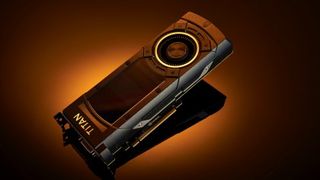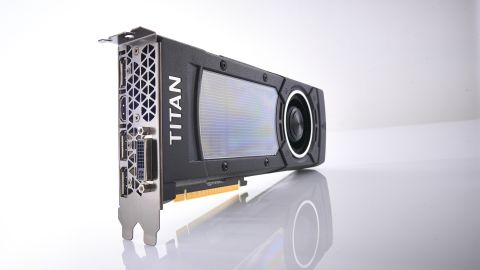Why you can trust TechRadar
So no, the Nvidia GeForce GTX Titan X can't call itself the fastest gaming graphics card available right now. That's because of the continued impressive performance of AMD's top-end R9 295X2 card.
The AMD Radeon R9 295X2 is still the fastest graphics card in terms of gaming, offering higher average frame rates in the latest titles at 4K resolutions. And if average frame rates were the whole story, you could happily conclude that the cheaper AMD card is a much better purchase than this pricey Titan X.
But they're not.
The Radeon is able to achieve its performance with its last-gen, soon-to-be-second-tier GPUs, because it's using two of them to power one card. It's a CrossFire setup on a single slice of circuit board. That's impressive, but it introduces a whole host of problems that the resolutely single GPU Titan X doesn't have to worry about.
For a start there's the power draw. The GeForce GTX Titan X only requires a 600W PSU in your PC where the R9 295X2 simply wouldn't cope under such restrictive power offerings.
On our test rig the Radeon draws a hefty 681W under 1600p gaming load, so ideally you're looking for a 1KW PSU for that monster.
That energy requirement also means it demands a closed-loop water cooler attached to both AMD GPUs to keep it cool enough to run at its rated speeds. And that takes a whole lot of space. The GTX Titan X could happily fit into a mini-ITX chassis, and still deliver a frighteningly powerful micro machine.
Then there are the vagaries of multi-GPU gaming. You can't always trust twin GPUs to deliver the performance you've paid for – we'd always recommend spending your graphics money on the fastest single GPU you can afford. Splitting the cash over two cards might net you some improvements in average frame rates, but often you'll be sacrificing smooth gaming to that particular god.

Multi-GPU setups can suffer from the dreaded micro-stutter. This is where the overall performance seems good, but the actual experience rings hollow as visible stutters interrupt the smooth running of your games.
You will also come across situations where, having picked up a game on launch day, you find at least one of your GPUs is sat twiddling its thumbs while you wait for the devs to update support for either SLI or CrossFire.
Such experiences are infrequent, and becoming even more so. We've run both AMD and Nvidia multi-GPU setups in the labs for years and things are definitely getting better, especially on day one performance. But still, a powerful single GPU will always be preferable to a less-trustworthy twin-GPU setup.
So, it's a similar situation to when the inaugural GTX Titan was released.
Back in 2013 we already had the GTX 690, with its twin GK 104 GPUs delivering speedy gaming performance. The first Titan fell a little short in terms of average frame rate but was able to offer a more elegant, efficient solution in a single GPU package.
The only difference today is that the GTX Titan X's competition is coming from AMD and not from within its own stable of cards.

The competition
With no single GPU competition from AMD (thanks to the tardy nature of the upcoming but still far off Fiji silicon in its Radeon R9 390X), Nvidia has almost been given a free pass with the GeForce GTX Titan X.
It's the fastest single GPU card around and delivers almost the same level of gaming performance as the dual-GPU behemoth from AMD, with more elegance and more efficiency.
Which means that Nvidia can easily charge this much cash simply for the privilege of owning a GeForce GTX Titan X.
That could change when the Radeon R9 390X turns up, with its touted $700+ price tag and high bandwidth memory configurations, but until then the GM 200 core in the Titan X stands alone.
Even so, this won't be the only consumer graphics card to rock the GM 200 GPU from Nvidia. There is almost certainly going to be a GeForce GTX 980 Ti released soon after AMD finally gets its R9 390X out of the door in the Summer.
We're betting on an August release for the GTX 980 Ti.
We liked
The GeForce GTX Titan X is an ultra desirable component. The fact it is able to produce the same level of gaming performance as the top dual-GPU AMD card is important, but what puts it in a league of its own is its ability to do that with half the power draw and without needing a full closed-loop water cooler.
I'm also rather stunned by the overclocking performance of our reference sample.
The Maxwell architecture tends to welcome a little light clock tweakery, but it's the fact it has such a bearing on gaming performance that really impresses. The mid-range GTX 960's GPU could be boosted by a huge amount, but it didn't really translate into much in the way of frame rate improvements.
That couldn't be further from the truth with the GM 200 and GTX Titan X.
I was able to close the gap between Titan X and R9 295X2 to almost indistinguishable levels with some easy tweaks, knocking the GPU up over 1,400MHz and the memory clock up to around 3,900MHz.
We disliked
Nvidia has dropped an unwelcome colour change on the latest Titan. The aluminium shroud of the original Titan was a total departure from the black plastic covers of previous Nvidia cards. This back to black aesthetic makes it look like the Titan's cheaper cousin to us.
But for an internal component that's close to an irrelevance.
What's of more consequence is the amount of money Nvidia is asking you to pay out for a GTX Titan X. At $999 it's prohibitive, not quite as bad as the GTX Titan Z, but still pretty damned high. But this is a top-of-the-line card, and a top-of-the-line price is part of the package.
Then there's gaming performance. Sure, it's the absolute fastest single gaming GPU on the planet, but it's by no means an unprecedented performance. There are still cheaper graphics cards around capable of delivering on the overall gaming speed, if not quite on the same elegant experience.
Verdict
Let's be honest, most of you reading this are not going to buy a GeForce GTX Titan X. It's simply too much money to spend on a single component for your average enthusiast.
But we're pretty sure you want one. You definitely should want one.
It's the fastest single GPU card around – an elegant, efficient package offering performance previously seen only in monstrously power-hungry dual-GPU cards.
It's the standard bearer for Nvidia's Maxwell architecture and shows just how far ahead of AMD its engineering teams are right now. Once they hit the 20nm process, the performance per Watt levels of these green cards is going to be enormous.
The only reason not to buy this powerful card is the price, but with a price this high, that's going to be a very compelling reason to a lot of people. If you're one of them, don't worry: there will surely be a more affordable GM 200-powered card rocking up before the end of the year.

Scientists inch closer to holy grail of memory breakthrough — producing tech that combines NAND and RAM features could be much cheaper to produce and consume far less power

Google adds biometric verification to Play Store to keep your in-store wallet safe

Quordle today – hints and answers for Wednesday, April 17 (game #814)
